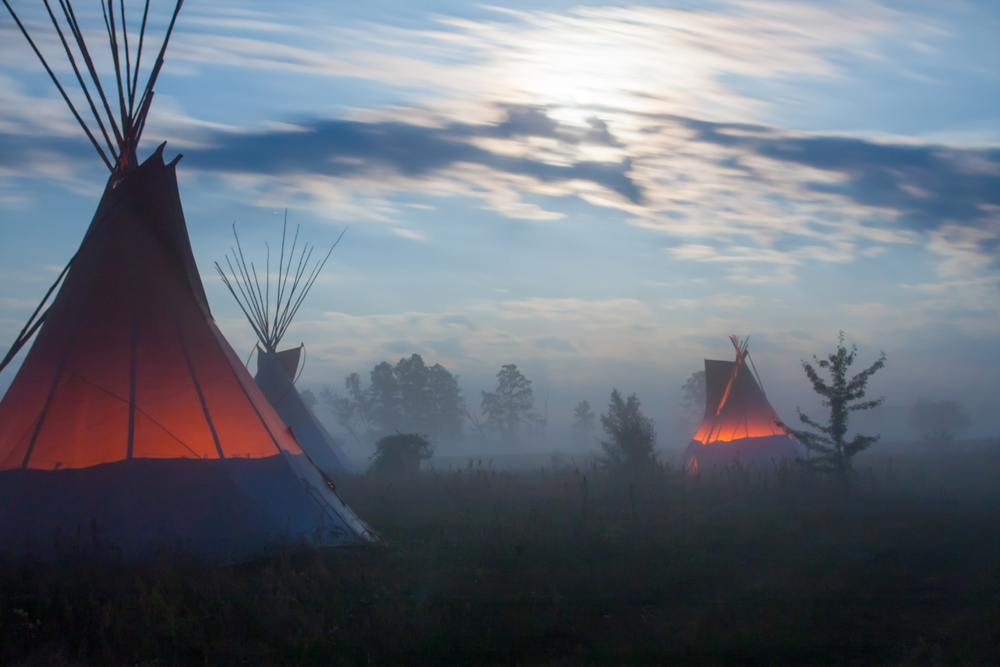
The History of the Teepee
February 23, 2025 2:37 pm Leave your thoughtsThe history of the teepee is deeply intertwined with the traditions and lifestyles of Indigenous peoples of the Great Plains in North America. The word “teepee” originates from the Lakota word “thípi,” meaning “dwelling” or “they dwell.” Unlike other forms of historical architecture, the teepee was uniquely suited to the nomadic lifestyle of Plains tribes such as the Lakota, Cheyenne, and Blackfoot.
Archaeological evidence suggests that conical structures similar to the teepee were used for thousands of years. Early teepees were made using wooden poles covered in animal hides, typically buffalo skins, which provided insulation and protection from harsh weather conditions. The design allowed for an efficient way to trap heat during winter while remaining cool in summer, making it an ideal home for tribes that moved frequently in pursuit of food and trade. Teepees also featured smoke flaps at the top, which allowed for the ventilation of fires used for cooking and warmth, demonstrating the ingenuity of Indigenous engineering.
Evolution of the Teepee’s Design
Over time, the teepee evolved in both structure and materials. Before European contact, Indigenous peoples relied on wooden poles, usually from lodgepole pines, which were lightweight yet durable. These poles were arranged in a circular formation, with a central tripod for support. The exterior covering was traditionally made from buffalo hides, which were sewn together using sinew and awl tools. A properly constructed teepee was not only portable but also easy to set up and dismantle, a necessity for nomadic life.
The arrival of European settlers in the 18th and 19th centuries introduced new materials, such as canvas, which many tribes adopted in place of buffalo hides. The use of canvas made teepees lighter and more durable, allowing for easier transportation. Additionally, trade with settlers brought iron tools, which made constructing and maintaining teepees more efficient. Despite these changes, the fundamental design of the teepee remained consistent due to its practicality and effectiveness in various climates.
Cultural and Spiritual Significance
Beyond being a functional shelter, the teepee held deep cultural and spiritual significance for Indigenous communities. The circular base symbolized the interconnectedness of life, representing the cycles of nature, the sun, and the unity of the tribe. The structure itself was often aligned with the cardinal directions, with the entrance traditionally facing east to welcome the morning sun.
Teepees were also adorned with painted designs that held personal and tribal meaning. Some were decorated with symbols representing achievements in battle, spiritual visions, or sacred animals. The process of erecting a teepee was often a communal effort, reinforcing social bonds and shared responsibilities within the tribe. Women were typically responsible for setting up and maintaining the teepee, reflecting their essential role in daily life and the home.
In ceremonies and gatherings, teepees played an essential role in spiritual practices. They served as places for council meetings, healing rituals, and storytelling, where oral traditions were passed down through generations. The sacred nature of the teepee was evident in its use for vision quests and sweat lodge ceremonies, emphasizing its role as a bridge between the physical and spiritual realms.
Teepees in a Changing World
The widespread displacement of Indigenous peoples during the 19th and 20th centuries had a profound impact on the use of the teepee. As Indigenous tribes were forced onto reservations, many were no longer able to maintain their traditional nomadic lifestyles. Government policies aimed at assimilation sought to replace traditional dwellings with European-style houses, leading to a decline in the everyday use of the teepee. However, despite these efforts, many Indigenous communities have continued to preserve and honor their architectural traditions.
In contemporary times, teepees are often seen at cultural festivals, powwows, and educational events, serving as a symbol of resilience and Indigenous identity. They are also used in traditional ceremonies and as a way for Indigenous youth to reconnect with their heritage. Some Indigenous groups have revived the practice of living in teepees, incorporating modern materials while maintaining traditional construction methods.
The Legacy of the Teepee in Modern Architecture
The teepee’s influence extends beyond Indigenous communities, as its design has inspired aspects of modern architecture. Its efficient conical shape, natural ventilation system, and portability have been studied by architects interested in sustainable and eco-friendly housing. The emphasis on living harmoniously with nature, which is central to the history of the teepee, aligns with contemporary discussions on sustainable design and environmental responsibility.
Architectural adaptations of the teepee have emerged in various forms, from eco-lodges to glamping structures that incorporate traditional aesthetics with modern amenities. Some experimental architects have drawn inspiration from Indigenous engineering principles, applying them to structures that emphasize low-impact living. Additionally, the teepee remains a powerful cultural symbol, reminding the world of the ingenuity and traditions of Indigenous peoples.
Conclusion
The history of the teepee is a testament to the resourcefulness, resilience, and spiritual depth of Indigenous cultures. From its early origins to its enduring legacy in historical architecture, the teepee represents more than just a shelter—it is a symbol of cultural identity, adaptability, and the deep connection between people and the natural world. As interest in sustainable living and Indigenous knowledge grows, the lessons embedded in the teepee’s design continue to resonate, offering valuable insights for both historical appreciation and future architectural innovation.
Need a Small Log Supplier in Lapoint, UT?
Categorised in: Teepee Tips
This post was written by admin
